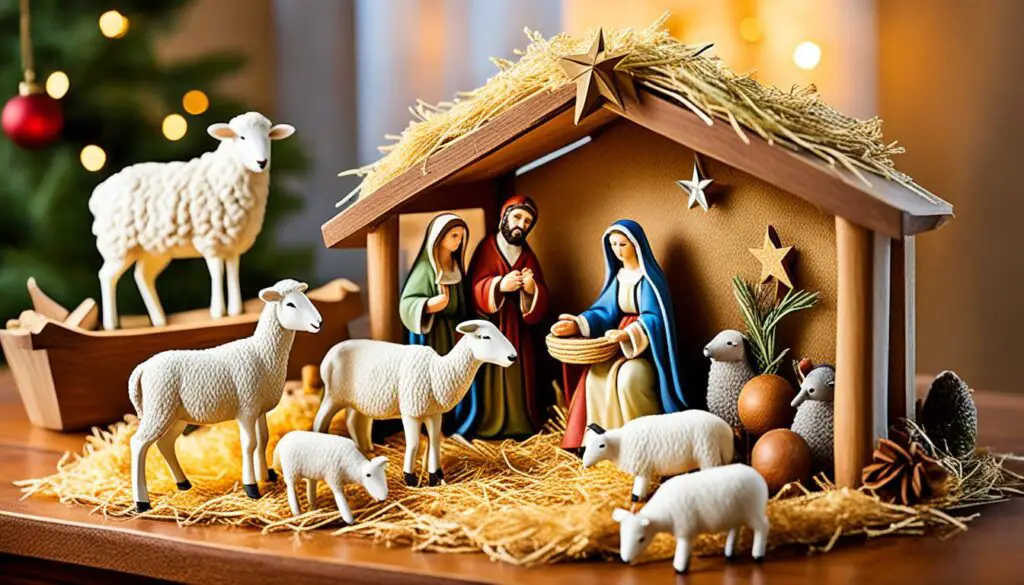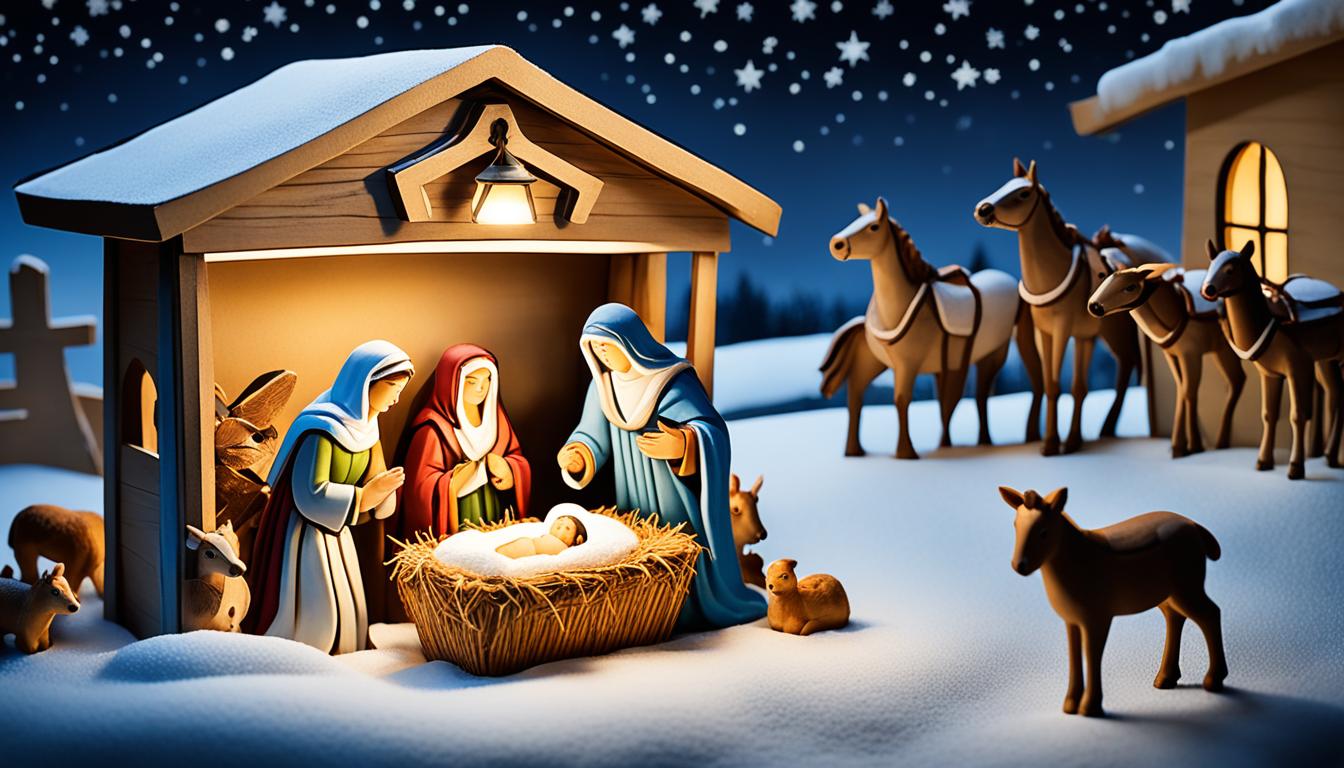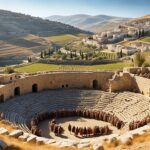The Nativity Story and the town of Bethlehem are deeply intertwined, forming the origins of Christmas and holding great significance in the Christian faith. The biblical gospels of Luke and Matthew document the birth of Jesus in Bethlehem to Mary and Joseph. While the historical accuracy of the nativity story may be debated, its impact on Christmas celebrations and the Christian belief in Jesus’ birth cannot be understated.
Key Takeaways:
- The Nativity Story is described in the biblical gospels of Luke and Matthew.
- Bethlehem is the town believed to be the birthplace of Jesus.
- The Nativity Story forms the basis of the Christian holiday of Christmas.
- The story holds deep significance in the Christian faith, symbolizing the beginning of Jesus’ redemptive mission.
- Bethlehem continues to attract visitors as a site of great religious importance.
The Birth of Jesus in Bethlehem
According to the biblical accounts, Jesus was born in Bethlehem, a town in Judaea. Mary and Joseph, who were engaged at the time, traveled to Bethlehem for a census. Jesus’ birth was believed to be divinely caused, and he was placed in a manger. This birth in Bethlehem is central to the nativity story and is celebrated as a significant event in the Christian tradition.
As described in Luke 2:4-7:
And Joseph also went up from Galilee, out of the city of Nazareth, into Judaea, unto the city of David, which is called Bethlehem; (because he was of the house and lineage of David:) To be taxed with Mary his espoused wife, being great with child. And so it was, that, while they were there, the days were accomplished that she should be delivered. And she brought forth her firstborn son, and wrapped him in swaddling clothes, and laid him in a manger; because there was no room for them in the inn.
This pivotal moment in Bethlehem signifies the fulfillment of ancient prophecies and marks the beginning of Jesus’ earthly journey. It symbolizes God’s plan for salvation and serves as a testament to the divine nature of Jesus’ birth.
The Biblical Nativity Stories
The nativity story is described in the gospels of Luke and Matthew. While both accounts agree on the birth in Bethlehem, they present different details and perspectives.
Luke’s Account
In Luke’s gospel, he emphasizes the journey of Mary and Joseph to Bethlehem. Mary, who was betrothed to Joseph, became pregnant through the Holy Spirit. They traveled from Nazareth to Bethlehem because of a census imposed by Caesar Augustus.
“And it came to pass in those days, that there went out a decree from Caesar Augustus that all the world should be taxed.” (Luke 2:1)
Upon their arrival in Bethlehem, Mary gave birth to Jesus in a humble manger, as there was no room for them in the inn. Luke highlights the angelic appearance to the shepherds in the fields, announcing the birth of Jesus and leading them to worship him. The shepherds witnessed the adoration of the baby Jesus and spread the good news.
Matthew’s Account
Matthew’s gospel approaches the nativity story from a different angle. He focuses on the visit of the Magi, also known as the Wise Men or the Three Kings, and King Herod’s sinister intentions. The Magi, guided by a star, traveled from the east to Jerusalem, asking King Herod about the location of the newborn King of the Jews.
“Now when Jesus was born in Bethlehem of Judaea in the days of Herod the king, behold, there came wise men from the east to Jerusalem.” (Matthew 2:1)
King Herod, feeling threatened by the news of a new king, devised a plan to eliminate the potential rival. He asked the Magi to inform him of Jesus’ whereabouts, intending to find and kill the child. However, the Wise Men, warned in a dream, returned to their country by another route, avoiding Herod’s malevolent scheme.
| Luke’s Account | Matthew’s Account |
|---|---|
| Emphasizes Mary and Joseph’s journey to Bethlehem | Focuses on the visit of the Magi and King Herod’s intentions |
| Highlights the angelic appearance to the shepherds | Includes the Wise Men guided by a star |
| Shepherds witness the adoration of baby Jesus | Herod seeks to find and kill the child |
The two biblical nativity narratives complement each other, offering distinct perspectives on the birth of Jesus. While some details may vary, they both affirm the central event of Jesus’ birth in Bethlehem and its profound impact on the Christian faith.

The Significance of the Nativity Story
The nativity story holds great significance in the Christian tradition. It is seen as the fulfillment of prophecies and the beginning of the redemptive mission of Jesus. The birth of Jesus in humble circumstances reflects the teachings of humility and compassion, embodying the core values of the Christian faith.
During the Christmas season, the nativity story is widely celebrated by Christians around the world. It serves as a reminder of the central message of love and salvation in their faith. The nativity scene, depicting the birth of Jesus in a stable with Mary and Joseph, is a common sight in churches, homes, and public spaces.
“For unto you is born this day in the city of David a Savior, who is Christ the Lord.” – Luke 2:11
The nativity story symbolizes hope and joy, bringing believers together to celebrate the miraculous birth of Jesus. It reaffirms their faith in the Christian narrative and serves as a reminder of the divine presence in their lives.
Through the nativity story, Christians reflect on the powerful message of God’s love for humanity and the promise of redemption. It is a time for prayer, worship, and acts of kindness, as believers strive to emulate the teachings of Jesus and spread joy and peace during the Christmas season.

The Nativity in Art and Culture
The nativity has long been a beloved subject for artists throughout history, inspiring countless works of art that capture the beauty and wonder of Jesus’ birth. Depictions of the nativity scene gained prominence in Christian art during the 4th century and have evolved in style and interpretation over time.
One of the most enduring traditions associated with the nativity is the display of nativity scenes during the Christmas season. These scenes, often crafted with intricate detail and symbolism, depict the humble stable where Jesus was born, surrounded by Mary, Joseph, the shepherds, the Magi, and various animals. From small figurines to elaborate installations, nativity scenes serve as a visual representation of the Christmas story and are cherished by believers worldwide.
In addition to static art, the nativity has also been brought to life through theatrical performances, such as nativity plays and pageants. These lively reenactments provide an interactive and immersive experience, inviting audiences to witness the story unfold before their eyes. Through music, dance, and acting, these productions engage both young and old, fostering a deeper connection to the nativity and its significance.
“The nativity story has inspired countless artists to create works that evoke a sense of awe and wonder. From Renaissance masterpieces to modern interpretations, these paintings and sculptures capture the essence of the Christmas tradition and allow us to reflect on the profound meaning behind Jesus’ birth.” – Art Historian
The Evolution of Nativity Art
Over the centuries, the nativity has been portrayed in various artistic styles and cultural contexts. From Byzantine icons to Renaissance paintings, each period brings its own unique interpretation to the scene. Artists strive to convey the sacredness of the moment, often utilizing vibrant colors, intricate details, and symbolic elements to create a visually stunning portrayal.
Here is a table showcasing notable artworks depicting the nativity:
| Artist | Artwork | Year |
|---|---|---|
| Leonardo da Vinci | The Virgin of the Rocks | 1483-1486 |
| Sandro Botticelli | The Mystical Nativity | 1500-1501 |
| Caravaggio | Adoration of the Shepherds | 1609 |
| Rembrandt | The Adoration of the Shepherds | 1646 |
| Paul Gauguin | Tahitian Christmas | 1896 |
Each artwork in this table offers a unique perspective on the nativity, reflecting the artist’s cultural background, artistic style, and personal interpretation of the story.

The enduring popularity of the nativity in art and culture highlights its importance as a symbol of the Christmas tradition. Whether through paintings, sculptures, or live performances, the nativity serves as a reminder of the profound story of Jesus’ birth and its relevance in our lives today.
Historical Context of the Nativity
The nativity story holds a significant place in history, set against a backdrop of political and social circumstances. Understanding the historical context enhances our appreciation of the events surrounding Jesus’ birth.
In the Gospel of Luke, the Roman census is referenced as the reason for Mary and Joseph’s journey to Bethlehem. This required individuals to return to their ancestral homes to be counted for taxation purposes. While the historical accuracy of this specific census is debated, it reflects the widespread practice of conducting censuses in the Roman Empire during that time.
King Herod’s role in the nativity story also contributes to the historical context. Herod was the Roman-appointed ruler of Judaea at the time, known for his ruthless reign. According to the Gospel of Matthew, Herod’s fear of a potential rival, the newborn “King of the Jews,” prompted him to order the massacre of all male infants in Bethlehem.
“Then Herod, when he saw that he was deceived by the wise men, was exceedingly angry; and he sent forth and put to death all the male children who were in Bethlehem and in all its districts, from two years old and under.” – Matthew 2:16
This historical context adds depth to the nativity story, showcasing the political climate and the challenges faced by Mary and Joseph during this momentous time.
Roman Census
The Roman census was a bureaucratic process designed to maintain control and gather accurate population data for taxation and military purposes. The mention of a census in the nativity story aligns with historical practices, providing a plausible reason for Mary and Joseph’s journey to Bethlehem.
King Herod
King Herod’s presence in the nativity story sheds light on the political climate of the time. Herod’s brutal reign was marked by fear and political intrigue. His ruthless actions, including the massacre of infants, demonstrate the lengths he was willing to go to maintain his power.
| Historical Context | Key Points |
|---|---|
| Roman Census | – The Roman census was a common practice in the empire |
| King Herod | – King Herod ruled over Judaea at the time of Jesus’ birth – Herod’s fear of a potential rival led to the massacre of infants in Bethlehem |
The Birth of Jesus and the Prophecies
The birth of Jesus in Bethlehem is widely regarded as the fulfillment of prophecies found in the Old Testament. These prophecies foretold the coming of a Messiah from the lineage of David who would bring salvation to the people. The nativity story, with Jesus’ birth in Bethlehem, is seen as the realization of these prophetic promises, solidifying the belief in Jesus as the long-awaited savior.
“But you, Bethlehem Ephrathah, though you are small among the clans of Judah, out of you will come for me one who will be ruler over Israel, whose origins are from of old, from ancient times.” – Micah 5:2 (NIV)
In Micah 5:2, the prophet Micah specifically prophesied that the Messiah would be born in Bethlehem, a small town in Judah. This prophecy aligns with the birthplace of Jesus, emphasizing the significance of his arrival in fulfilling divine plans.
Another notable prophecy is found in Isaiah 7:14, stating that a virgin would conceive and give birth to a son who would be called Immanuel, meaning “God with us.” This prophecy is seen as fulfilled in the birth of Jesus, where Mary, a virgin, conceives by the Holy Spirit and gives birth to the Son of God.
This alignment between the prophecies of the Old Testament and the birth of Jesus in Bethlehem adds to the conviction and faith of believers, affirming the divinity and purpose of Jesus’ arrival on earth.
| Prophecy | Fulfillment |
|---|---|
| Micah 5:2 | Jesus was born in Bethlehem, fulfilling the prophecy of a ruler coming from the town. |
| Isaiah 7:14 | Mary, a virgin, conceives and gives birth to Jesus, the promised Immanuel. |
| Jeremiah 23:5-6 | Jesus fulfills the role of the righteous Branch and establishes justice and righteousness. |
| Psalm 22:16 | Jesus’ crucifixion fulfills the prophecy of piercing his hands and feet. |
The Fulfillment of Prophecies in the Birth of Jesus
When examining the birth of Jesus through the lens of prophecy fulfillment, it becomes evident that his arrival in Bethlehem was not a mere coincidence but a deliberate manifestation of God’s divine plan. The alignment between these prophecies and the events surrounding Jesus’ birth strengthens the faith of believers and affirms the profound significance of the nativity story.
The Role of Mary and Joseph
Mary and Joseph, the parents of Jesus, play central roles in the nativity story. Their unwavering faith and obedience to divine will are celebrated in Christian tradition.
Mary: Mary’s significance as the mother of Jesus cannot be overstated. Her willingness to bear the child, despite the social implications, demonstrates her deep faith and obedience to God’s plan. Mary’s faithful acceptance of this divine responsibility showcases her remarkable strength and devotion.
Joseph: Joseph, too, plays a crucial role in the nativity story. Chosen by God to be the earthly father of Jesus, Joseph demonstrates his unwavering commitment to Mary and his role as a protector and provider. His adherence to angelic guidance in accepting Mary’s pregnancy solidifies his significance in the nativity story.
The journey of Mary and Joseph to Bethlehem further exemplifies their faithfulness. Despite the challenges they faced, such as the long and arduous journey and the lack of suitable accommodations, they remained steadfast, trusting in God’s plan.
“Do not be afraid to take Mary as your wife, for the child conceived in her is from the Holy Spirit.” – Matthew 1:20
The circumstances surrounding Jesus’ birth highlight the importance of Mary and Joseph’s obedience to divine will. Their unwavering faith and trust in God’s plan ensure the fulfillment of prophetic promises and pave the way for the birth of the Savior.

| Role | Mary | Joseph |
|---|---|---|
| Significance | Bearer of Jesus, central figure in Christianity | Protector and provider, chosen earthly father of Jesus |
| Attributes | Willingness, faithfulness, humility | Trust, obedience, righteousness |
| Actions | Accepted divine responsibility, journeyed to Bethlehem | Protected Mary and Jesus, followed angelic guidance |
The Shepherds and the Magi
The nativity story includes the visits of both shepherds and Magi. The shepherds, who were tending their flocks in the fields, received an angelic visitation announcing the birth of Jesus. They then traveled to see the baby and offered their adoration. The Magi, guided by a star, visited Jesus and presented him with gifts. These visits signify the universal significance of Jesus’ birth.
To understand the significance of the shepherds’ and Magi’s visits, it is important to delve deeper into these key aspects of the nativity story. The shepherds, often depicted as humble and ordinary, were chosen to be among the first witnesses to Jesus’ birth. Their presence emphasizes the accessibility of Jesus’ message and the inclusive nature of his mission.
“And in the same region there were shepherds out in the field, keeping watch over their flock by night. And an angel of the Lord appeared to them, and the glory of the Lord shone around them, and they were filled with great fear. And the angel said to them, ‘Fear not, for behold, I bring you good news of great joy that will be for all the people. For unto you is born this day in the city of David a Savior, who is Christ the Lord. And this will be a sign for you: you will find a baby wrapped in swaddling cloths and lying in a manger.’” – Luke 2:8-12
The shepherds’ visitation symbolizes the invitation for all people, regardless of social status, to approach Jesus with reverence and adoration. Their adoration of the baby Jesus reflects the humility and recognition of his divine presence.
On the other hand, the Magi, also known as the Wise Men or the Three Kings, were scholars and astrologers who traveled from the East. Inspired by a star, they followed its guidance, which led them to where Jesus was born. The Magi’s journey and adoration of Jesus demonstrate the recognition of his royal and divine identity.
“Now after Jesus was born in Bethlehem of Judea in the days of Herod the king, behold, wise men from the east came to Jerusalem, saying, ‘Where is he who has been born king of the Jews? For we saw his star when it rose and have come to worship him.’ When they saw the star, they rejoiced exceedingly with great joy. And going into the house, they saw the child with Mary his mother, and they fell down and worshiped him. Then, opening their treasures, they offered him gifts, gold and frankincense and myrrh.” – Matthew 2:1-2, 10-11
The Magi’s recognition of Jesus’ kingship and their offering of precious gifts symbolize the acknowledgment of his divine status and their desire to honor him. Their presence in the nativity story emphasizes the global significance of Jesus’ birth, transcending cultural and geographical boundaries.
Together, the visits of the shepherds and the Magi highlight the universal appeal and impact of Jesus’ birth. Their encounters with the baby Jesus signify the diverse responses that people can have when confronted with the presence of the divine. Whether ordinary shepherds or esteemed scholars, all individuals are invited to approach Jesus with reverence, adoration, and the willingness to offer their precious gifts.
| Shepherds | Magi |
|---|---|
| Tending their flocks in the fields | Traveling from the East |
| Received angelic visitation | Guided by a star |
| Offered adoration | Presented gifts of gold, frankincense, and myrrh |
| Symbolize the accessibility of Jesus’ message | Recognize Jesus’ royal and divine identity |

The Nativity and Christmas Traditions
The nativity story holds a special place in the hearts of people around the world, and it serves as the foundation for many cherished Christmas traditions. One such tradition is the performance of nativity plays, also known as Christmas pageants, in schools and churches. These plays beautifully retell the story of Jesus’ birth, allowing participants and spectators to engage with the timeless narrative.
Nativity plays often feature children portraying the characters from the nativity story, including Mary, Joseph, the shepherds, and the Magi. Through their performances, these young actors not only bring the story to life but also experience the wonder and awe that surrounds the birth of Jesus.
“Christmas pageants are a wonderful way to involve children in the celebration of Jesus’ birth and teach them about the true meaning of Christmas,” says Sarah Thompson, a Sunday school teacher from Holy Cross Church.
Another popular Christmas tradition associated with the nativity story is the display of nativity scenes in households. These scenes, often consisting of figurines representing Jesus, Mary, Joseph, the shepherds, and the Magi, among others, serve as visual reminders of the central message of Christmas – the birth of Jesus. Placed under the Christmas tree or on a mantelpiece, nativity scenes serve as a focal point for reflection and celebration during the holiday season.
The nativity story and its symbolism continue to inspire holiday celebrations around the world. Whether it is through the heartfelt performances of nativity plays or the display of nativity scenes in homes, the story of Jesus’ birth resonates with individuals and communities, reminding them of the true meaning of Christmas.
Why are Nativity Plays Important?
Nativity plays play a vital role in connecting children and adults alike to the story of Jesus’ humble birth. Through rehearsals, costumes, and performances, participants gain a deeper understanding of the nativity story and its significance in the Christian faith. Moreover, witnessing or taking part in a nativity play can evoke feelings of joy, wonder, and gratitude, fostering a sense of community and togetherness during the holiday season.
Bethlehem – The Setting of the Nativity
Bethlehem, known as the birthplace of Jesus, holds a special place of significance in the nativity story. Situated in the Holy Land, this ancient town is closely connected to the lineage of King David, adding historical weight to its role in the biblical narrative. Today, Bethlehem continues to draw visitors from all over the world, eager to experience the essence of Jesus’ birthplace and deepen their understanding of the nativity story.
The town of Bethlehem is located in the West Bank, a region rich in cultural and religious heritage. It is a place where ancient traditions meet modern realities, offering a unique glimpse into the historical and spiritual aspects of the Christian faith. Visitors can explore Bethlehem’s narrow streets, visit sacred sites, and immerse themselves in the rich tapestry of its past and present.
The Church of the Nativity, a UNESCO World Heritage site, stands as a testament to Bethlehem’s importance in Christian history. This remarkable church, dating back to the 4th century, is built over the traditional site of Jesus’ birth. It attracts pilgrims and tourists alike, who come to pay homage to the birthplace of the Messiah.
Walking through the bustling markets of Bethlehem, visitors can perceive the vibrant energy of this storied town. The Arabic influence, mingled with Christian heritage, creates a unique atmosphere that captivates the senses. Local artisans display their crafts, offering beautifully handcrafted items such as olive wood carvings, ceramics, and intricate embroidery.
“Bethlehem reminds us of the humble beginnings of Jesus, born in a stable amidst the simplicity of a manger. It is a place where God’s love came to dwell among us, inviting us to embrace the joyous message of salvation and redemption.”
For believers and non-believers alike, visiting Bethlehem is an opportunity to connect with the timeless story that has shaped human history. Walking in the footsteps of Mary and Joseph, standing in the place where Jesus was born, evokes a sense of awe and reverence.
As visitors explore Bethlehem’s holy sites, they can also engage with the local community, experiencing the warm hospitality and deep-rooted traditions firsthand. Sharing meals, engaging in cultural exchanges, and participating in religious rituals offer a glimpse into the lives of the people who call Bethlehem home.
Ultimately, Bethlehem is a destination that offers not only historical and religious significance but also an opportunity for personal reflection and spiritual growth. It is a place where the nativity story becomes tangible and the message of hope and peace resonates strongly in the hearts of those who journey to this sacred land.
Conclusion
The Nativity Story, set in Bethlehem, is a timeless and cherished tale that illuminates the origins of Christmas and the heart of the Christian faith. This significant event symbolizes the hope and joy associated with the birth of Jesus, serving as a reminder of the central message of love, salvation, and the divinity of Christ.
Throughout the centuries, Christmas celebrations and traditions worldwide have been deeply influenced by the Nativity Story. From nativity plays and pageants to the display of nativity scenes in homes and churches, the story continues to inspire believers to embrace the true spirit of Christmas.
Bethlehem, known as the birthplace of Jesus, holds a special place in the hearts of Christians around the world. It is a destination of great religious importance and attracts visitors from far and wide who seek to experience the sacredness of this holy site.
As we celebrate Christmas each year, let us reflect on the Nativity Story and its profound impact on our faith and traditions. May it serve as a reminder of the love, hope, and salvation that Jesus brings into our lives, and may the spirit of Christmas continue to fill our hearts with joy and peace.
FAQ
What is the significance of the Nativity story?
The Nativity story holds great significance in the Christian tradition as it is seen as the fulfillment of prophecies and the beginning of the redemptive mission of Jesus. It reminds believers of the central message of love and salvation in their faith.
Where was Jesus born according to the Nativity story?
According to the Nativity story, Jesus was born in Bethlehem, a town in Judaea.
What are the biblical accounts of the Nativity?
The Nativity story is described in the gospels of Luke and Matthew.
Why is the Nativity story celebrated during the Christmas season?
The Nativity story is celebrated during the Christmas season as it forms the basis of the Christian holiday of Christmas. It symbolizes the hope and joy associated with the birth of Jesus.
What is the historical context of the Nativity?
The Nativity story is set in a specific historical context with references to the Roman census and King Herod’s role, reflecting the political climate of the time.
Who were Mary and Joseph in the Nativity story?
Mary and Joseph were the parents of Jesus and played central roles in the Nativity story. Mary’s faithfulness and Joseph’s role as the protector and provider are emphasized.
Who visited Jesus in the Nativity story?
The Nativity story includes visits from both shepherds and Magi. The shepherds received an angelic visitation and then traveled to see the baby Jesus, while the Magi were guided by a star and presented gifts to him.
What are some Christmas traditions associated with the Nativity?
Nativity plays and pageants are performed in schools and churches, retelling the story of Jesus’ birth. Many households also display nativity scenes during the holiday season as a reminder of the central message of Christmas.
What is the significance of Bethlehem in the Nativity story?
Bethlehem is traditionally believed to be the birthplace of Jesus and holds a special place in Christian pilgrimage as a site of great religious importance.
What is the significance of the Nativity story for Christmas celebrations?
The Nativity story remains a timeless and cherished tale that illuminates the origins of Christmas and the heart of the Christian faith. It reminds believers of the central message of love, salvation, and the divinity of Christ.







